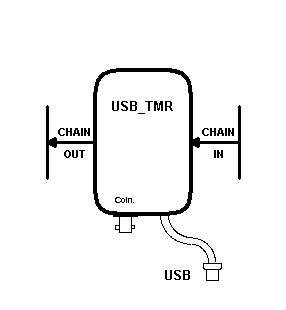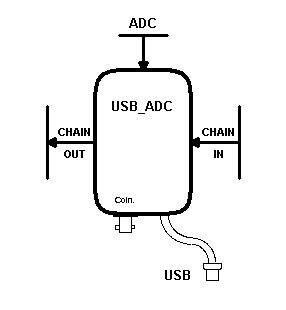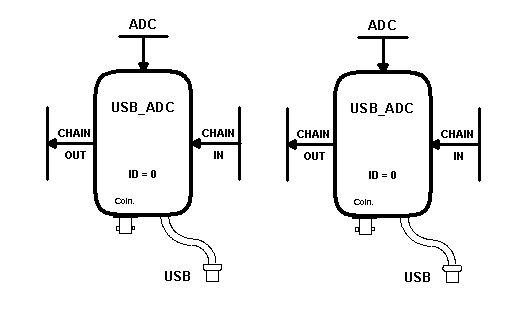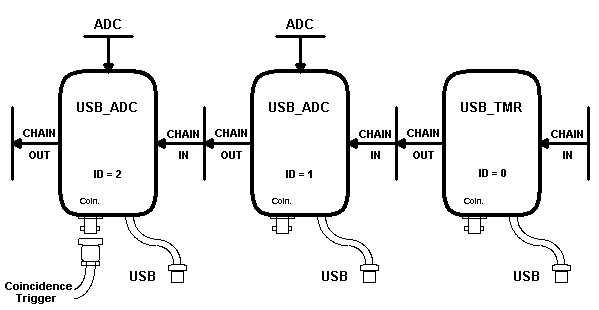ACQ - Hardware
The acquisition program supports I/O modules with
specific characteristics:
1. The device control register is 8-bits with
the lower 4-bits having common functionality
to enable/disable acquisiition, set the acquisition
mode to single/multiparameter, and initiate
a 'Test' USB data transfer cycle.
2. The device data register is 16-bits with
the lower 13-bits the acquisition data and
the top 3-bits the physicsl ID of the I/O module.
Currently two I/O modules are supported by the acquisition
program: The USB_ADC and USB_TMR modules. Usually each
I/O module has an input plug on the right side and an
output socket on the left side. The input plug allows
jumpering of the ID bits to change the default ID of a
single I/O module or the default starting ID of chained
I/O modules. These I/O devices will be depicted as shown in
the following drawings for the USB_TMR and USB_ADC modules:


-
Acquisition Hardware Configuration

Independent I/O Modules
The basic acquisition configuration is the single
(independent) I/O module. A single I/O module is configured
as a 1 element chain. Multiple independent I/O modules
are each configured as 1 element chains. The physical
ID of the I/O module can be set by jumpering the input
ID bits. The default physical ID is 0, this corresponds
to an instrument ID of 1 in the acquisition program.
A typical independent I/O module configuration is
shown with two USB_ADC modules. Each module has the
same ID (=0). However, the acquisition program will
will assign each module to seperate 1 element chains.


Chained I/O Modules
A string of daisy-chained I/O modules, not to exceed
8 I/O modules, is configured as a multi-element chain.
The physical I/O module's ID is determined by its
location in the chain. The first I/O module in the
chain must have the lowest ID number within the chain
(required by the acquisition program). The actual ID
of the first I/O module can be set by jumpering the
input ID bits (as shown on the I/O module). Each
subsequent I/O module then has an ID one higher than
its predecessor. The default physical ID of the first
I/O module is 0, this corresponds to an instrument ID
of 1 in the acquisition program.
A typical chained I/O module configuration is shown
with a USB_TMR and two USB_ADC modules. The module
physical IDs will be, from right to left, 0 for the
USB_TMR and then 1 and 2 for the following USB_ADC
modules. A single 'coincidence trigger' signal is
required if two or more of the I/O modules are to be
operated in the multiparameter acquisition mode. The
trigger signal is passed through the 'chain' and
synchronizes each participating I/O module to acquire
data simultaneously.







